Sony VPL-DX220, VPL-DX240 User Manual

4-593-103-11 (2)
Data
Projector
Operating Instructions
Before operating the unit, please read this manual and supplied Quick Reference Manual thoroughly and retain it for future reference.
VPL-DX270/DX240/DX220
VPL-DW240
Not all models are available in all countries and area. Please check with your local Sony Authorized Dealer.
© 2016 Sony Corporation

Table of Contents |
|
Overview |
|
Location and Function of Controls .... |
3 |
Main Unit ..................................... |
3 |
Terminal Panel .............................. |
4 |
Remote Commander and Control |
|
Panel Keys ................................. |
5 |
Preparation |
|
Connecting the Projector ................... |
7 |
Connecting a Computer ................ |
7 |
Connecting a Video equipment .... |
8 |
Connecting to an external |
|
device ........................................ |
9 |
Supplying the power to the external |
|
device ........................................ |
9 |
Projecting an Image |
|
Projecting an Image ......................... |
10 |
Adjusting the Projected image ... |
11 |
Turning Off the Power ................ |
15 |
Adjustments and Settings |
|
Using a Menu |
|
Using a MENU ................................ |
17 |
The Picture Menu ............................. |
18 |
The Screen Menu ............................. |
19 |
The Function Menu .......................... |
23 |
The Operation Menu ........................ |
24 |
The Connection/Power Menu .......... |
25 |
The Installation Menu ...................... |
27 |
The Information Menu ..................... |
28 |
Others |
|
Indicators .......................................... |
29 |
Messages List ................................... |
31 |
Troubleshooting ................................ |
32 |
Replacing the Lamp .......................... |
34 |
Cleaning the Air Filter ...................... |
36 |
When Using the Projector by Mounting |
|
It to a Ceiling ................................ |
37 |
Removing the lens cap ................ |
37 |
Attaching the dust cover ............. |
37 |
Cleaning the air filter and its |
|
surroundings ............................ |
38 |
Carrying the unit ............................... |
38 |
Specifications ................................... |
39 |
Projection Distance ........................... |
44 |
Dimensions ....................................... |
49 |
Index ................................................. |
52 |
2 Table of Contents
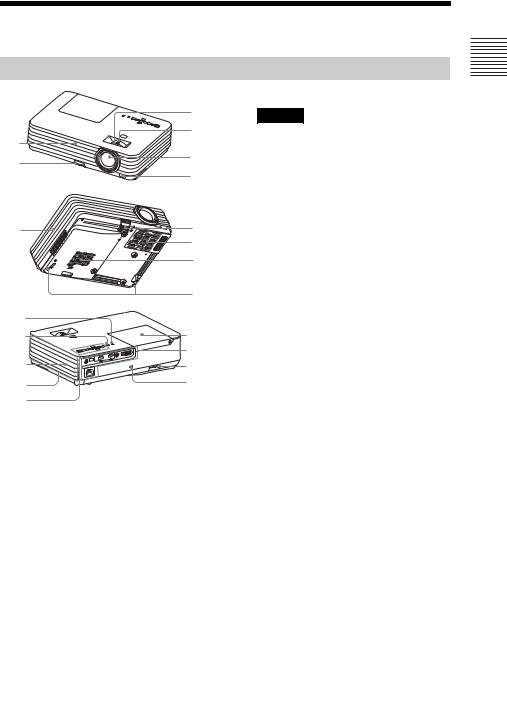
B Overview
Location and Function of Controls
Main Unit
1
2
qg
5 |
3 |
|
4 |
||
|
||
9 |
6 |
|
7 |
||
|
||
|
qg |
|
|
8 |
qk |
|
qj |
0 |
|
qa |
qh |
qs |
qg |
qd |
qf |
|
a Focus ring (page 11) |
|
b Zoom ring (page 11) |
|
c Lens |
|
d Remote control detector
e Foot adjust button (page 13)
f Front foot (adjustable) (page 13)
gAir filter cover/Ventilation holes (intake) (page 36)
h Rear feet (page 13)
i Ventilation holes (exhaust)
Caution
Do not place anything near the ventilation holes as this may cause internal heat buildup. Do not place your hand near the ventilation holes and the circumference as this may cause injury.
j Lamp cover (page 34) k Terminal panel (page 4)
lSecurity bar
Connects to a commercially available security chain or wire.
mSecurity lock
Connects to an optional security cable manufactured by Kensington.
For details, visit Kensington’s web site. http://www.kensington.com/
n Control panel keys (page 5) o Ventilation holes (intake) p Speaker
q WARNING indicator (page 29)
rON/STANDBY indicator (page 29)
Overview
Location and Function of Controls |
3 |
|
|

Terminal Panel
VPL-DX220
6 2 4 1
7

VPL-DX240/DX270/DW240
6 5 3 2 4 1
7

Input (pages 7, 8)
aINPUT A
Video: RGB/YPBPR input terminal
bINPUT B
Video: HDMI input terminal Audio: HDMI input terminal
cINPUT C*
Video: HDMI input terminal Audio: HDMI input terminal
*VPL-DX240/DX270/DW240 only
dVIDEO IN
Video: Video input terminal
Output
ePower Supply*
USB terminal (Type A)(5V/2A)
*VPL-DX240/DX270/DW240 only
fAUDIO OUTPUT
Audio: Audio output terminal (AUDIO)
Note
The audio is output only when the INPUT B terminal or the INPUT C terminal is selected.
Others
gAC IN ( ) socket
Connects the supplied AC power cord.
4 Location and Function of Controls

Remote Commander and Control Panel Keys
Remote Commander
|
|
|
|
7 |
4 |
|
|
|
1 |
|
|
|
|
|
INPUT |
APA |
ECO MODE |
|
6 |
2 |
|
|
|
|
MENU |
|
|
RESET |
|
3 |
ENTER |
|
|
|
|
|
|
||
RETURN |
|
|
|
|
ASPECT |
KEYSTONE |
PATTERN |
|
|
4 |
|
|
BLANK |
|
D ZOOM |
VOLUME |
FREEZE |
MUTING |
5 |
Control Panel Keys
aTurning on the power/Going to standby mode
?/1 (On/Standby) key
bSelecting an input signal (page 10)
INPUT key
cOperating a menu (page 17)
MENU key RESET key
ENTER /V/v/B/b (arrow) keys
RETURN key
dAdjusting the image (page 11)
ASPECT key (page 19) KEYSTONE key (page 14)
PATTERN key (page 12)
APA (Auto Pixel Alignment) key* (page 14)
Note
*Use this key when inputting a computer signal via the RGB input terminal (INPUT A).
eUsing various functions during projecting
D ZOOM (Digital Zoom) +/– key*1
Enlarges the image with the center of it as a starting point while projecting.
1Press the D ZOOM + key to display the digital zoom icon on the projected image.
2Press the V/v/B/b keys to move the digital zoom icon to the point on the image you want to enlarge.
3Press the D ZOOM + key or the D ZOOM – key repeatedly to change the
enlargement ratio. The image can be enlarged up to 4 times.
Press the RESET key to restore the previous image.
Overview
Location and Function of Controls |
5 |
|
|
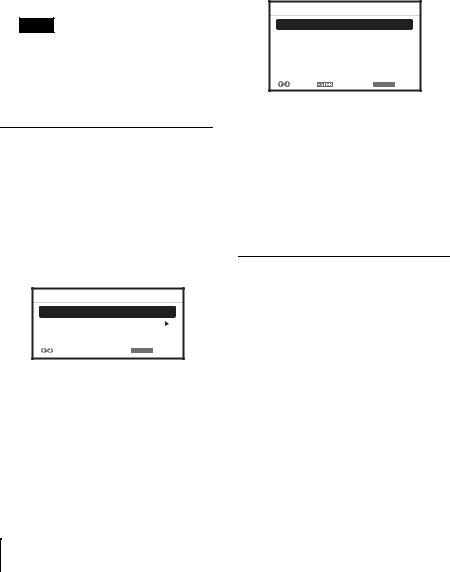
BLANK key
Cuts off the projected image temporarily. Press again to restore the previous image. Picture muting helps reduce power consumption.
MUTING key
Mutes the audio output temporarily. Press again to restore the previous volume.
VOLUME +/– key
Adjusts the volume output.
FREEZE key*2
Pauses a projected image. Press again to restore the image.
Notes
*1: Use this key when inputting a computer signal. But it may not be used depending on the resolution of the input signal.
*2: Use this key when inputting a computer signal.
fSetting the energy–saving mode easily
ECO MODE key
Energy-saving mode can be set easily. Energy-saving mode consists of “Lamp Mode,” “With No Input,” and “With Static Signal.”
1Press the ECO MODE key to display the ECO Mode menu.
ECO Mode Menu
ECO Mode
ECO
User
:Sel |
RETURN :Back |
2Press the V/v key or ECO MODE key to select “ECO” or “User” mode. ECO: Sets each mode to the optimum
energy-saving value. Lamp Mode: Low With No Input: Standby
With Static Signal: Lamp Dimming
User: Sets each item of the ECO mode menu as you desire (go to step 3).
3Select “User” then press the b key. The setting items appear.
User
Lamp Mode |
|
High |
Auto Power Saving |
|
|
With No Input |
Off |
|
With Static Signal |
Lamp Dimming |
|
:Sel |
:Set |
RETURN :Back |
4Press the V/v key to select the item then press the ENTER key.
5Press the V/v key to select the setting value.
6Press the ENTER key.
The screen returns to the previous menu.
For details on ECO Mode settings, see “Lamp Mode”, “With No Input” and “With Static Signal” on the Connection/ Power menu (page 25).
g Infrared transmitter
About remote commander operation
•Direct the remote commander toward the remote control detector.
•The shorter the distance between the remote commander and the projector is, the wider the angle within which the remote commander can control the projector becomes.
•Make sure that nothing obstructs the infrared beam between the remote commander and the remote control detector on the projector.
6 Location and Function of Controls
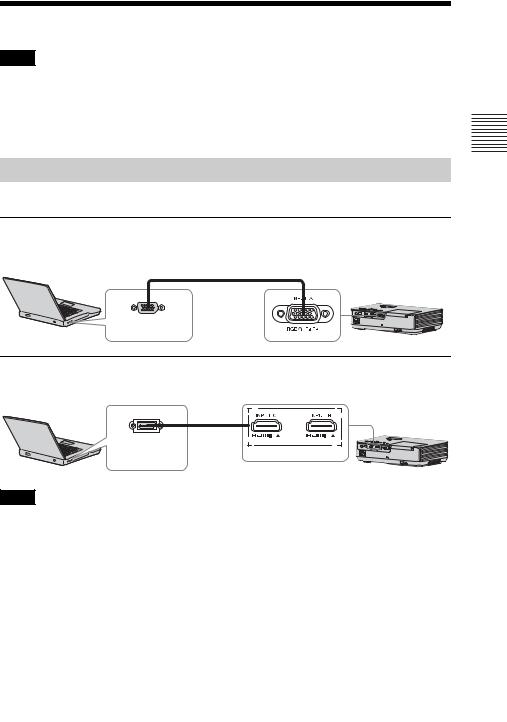
B Preparation
Connecting the Projector
Notes
•Make sure all the equipment is powered off when connecting the projector.
•Use the proper cables for each connection.
•Insert the cable plugs firmly; Loose connections may reduce performance of picture signals or cause a malfunction. When pulling out a cable, be sure to grip it by the plug, not the cable itself.
•For more information, refer also to the instruction manuals of the equipment you are connecting.
•Use a no-resistance audio cable.
Connecting a Computer
Connection with a computer is explained for each input signal.
INPUT A
For connecting a computer with an RGB output terminal.
Mini D-sub 15-pin cable (supplied)
Preparation
|
RGB output |
Computer |
terminal |
INPUT B/INPUT C
For connecting a computer with an HDMI output terminal.
HDMI output |
HDMI |
|
cable (not |
||
terminal |
||
supplied) |
||
|
Computer
Notes
•Only VPL-DX270/DX240/DW240 has the INPUT C terminal.
•Use HDMI-compatible equipment and cable(s) that have an HDMI logo on them.
•Use a high speed HDMI cable(s) on which the cable type logo is specified. (Sony products are recommended.)
•The HDMI terminal of this projector is not compatible with DSD (Direct Stream Digital) Signal or CEC (Consumer Electronics Control) Signal.
•The resolutions of the projected image may vary depending on the input terminals.
•It is recommended that you set the resolution of your computer to 1024 × 768 pixels (VPL-DX270/ DX240/DX220) or 1280 × 800 pixels (VPL-DW240) for the external monitor.
Connecting the Projector |
7 |
|
|
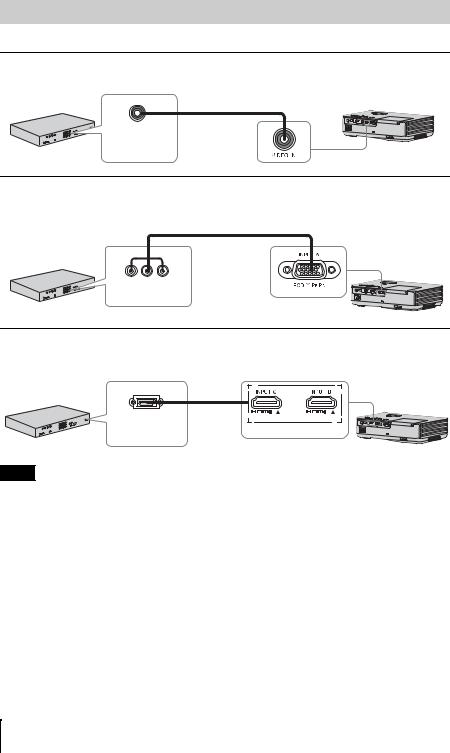
Connecting a Video equipment
Connections with a DVD player or BD player are explained for each input signal.
VIDEO
For connecting video equipment with a video output terminal.
Video cable (not supplied)
Video output terminal
Video equipment
INPUT A
For connecting video equipment with a YPBPR output terminal.
Component – Mini D-sub 15-pin cable (not supplied)
YPBPR output terminal
Video equipment
INPUT B/INPUT C
For connecting video equipment with an HDMI output terminal.
|
HDMI output |
HDMI |
|
cable |
|
|
terminal |
|
|
(not |
|
|
|
|
Video equipment |
|
supplied) |
Notes
•Only VPL-DX270/DX240/DW240 has the INPUT C terminal.
•Use HDMI-compatible equipment and cable(s) that have an HDMI logo on them.
•The HDMI terminal of this projector is not compatible with DSD (Direct Stream Digital) Signal or CEC (Consumer Electronics Control) Signal.
•Use a high speed HDMI cable(s) on which the cable type logo is specified. (Sony products are recommended.)
•The maximum resolution of the INPUT C terminal is set to 720p.
8 Connecting the Projector
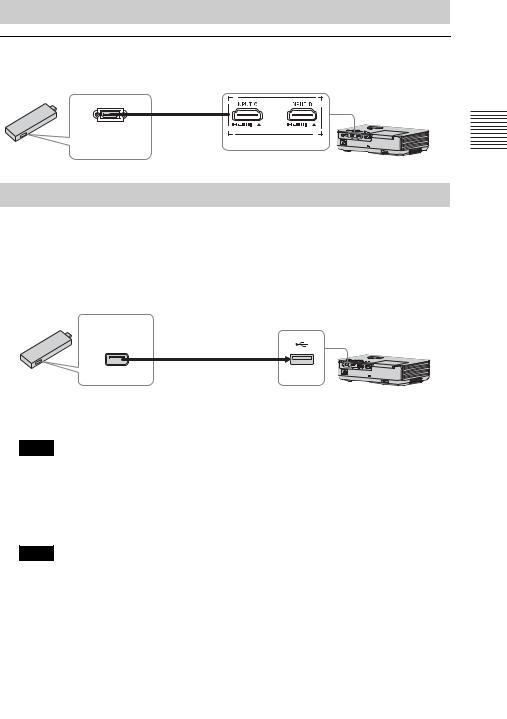
Connecting to an external device
INPUT C
For connecting an external device with an HDMI output terminal. Connect the external device to INPUT C.
HDMI cable HDMI output (not supplied)
terminal
External device
Supplying the power to the external device
The unit supplies power (5V/2A maximum) via the USB cable to the external device (stick type PC, etc.).
1 Connect the unit to the external device using the USB cable (with type A USB terminal).
USB terminal
(Type A) USB cable
(type A USB terminal)
Stick type external devices with HDMI |
Power supply |
output terminal, such as wireless devices, |
terminal |
small-sized PC, etc. (not supplied) |
|
Notes
•Use external devices with the appropriate specification for using this unit.
•If you connect the unit in wrong ways, the external device may cause a malfunction. In this case, Sony assumes no responsibility.
2 Set “Power Supply” to “On” in the Connection/Power menu (page 25).
The unit supplies power to the external device through the USB cable.
Notes
•Only VPL-DX270/DX240/DW240 has the INPUT C terminal.
•Use HDMI-compatible equipment and cable(s) that have an HDMI logo on them.
•The HDMI terminal of this projector is not compatible with DSD (Direct Stream Digital) Signal or CEC (Consumer Electronics Control) Signal.
•Use a high speed HDMI cable(s) on which the cable type logo is specified. (Sony products are recommended.)
•The maximum resolution of the INPUT C terminal is set to 720p.
Preparation
Connecting the Projector |
9 |
|
|

B Projecting an Image
Projecting an Image
The size of a projected image depends on the distance between the projector and screen. Install the projector so that the projected image fits the screen size. For details on projection distances and projected image sizes, see “Projection Distance” (page 44).
Input
Video
Input-A
Input-B
Input-C

 Sel
Sel
3 5
|
|
4 |
|
2 |
|
|
|
Video equipment |
Projector |
|
|
1 |
Wall outlet |
6 |
|
|
Computer |
1 Plug the AC power cord into the wall outlet.
2 Connect all equipment to the projector (page 7).
3 Press the ?/1 key to turn on the unit.
4 Turn on the connected equipment.
5 Select the input source.
Press the INPUT key on the projector to display the menu for switching input signal on the screen. Press the INPUT key repeatedly, or press the V/v key to select an image to be projected.
6 When projecting a computer image, switch your computer’s output to external display.
The method to switch the output varies depending on the type of computer.
(Example)
 +
+ 
7 Adjust the focus, size and position of the projected image (page 11).
10 Projecting an Image
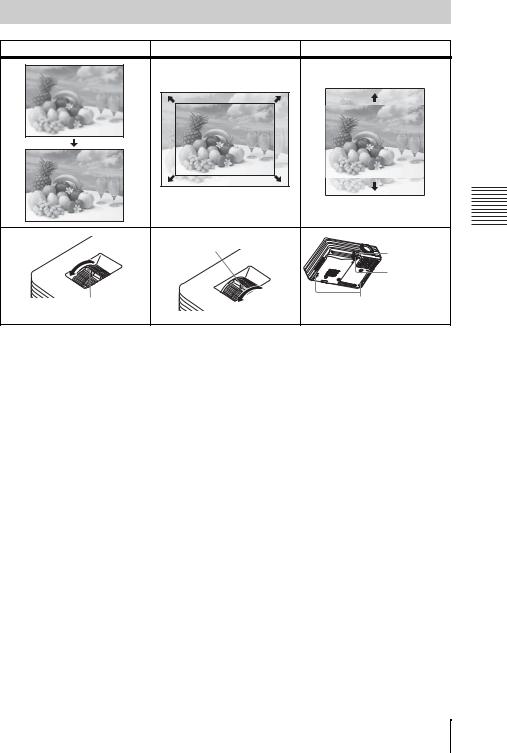
Adjusting the Projected image |
|
|
|
Focus |
Size (Zoom) |
Position |
|
|
Zoom ring |
Foot adjust |
Projecting |
|
|
button |
|
|
|
Front foot |
|
|
|
(adjustable) |
an |
Focus ring |
|
Rear feet |
|
|
Image |
||
|
|
|
|
Projecting an Image 11
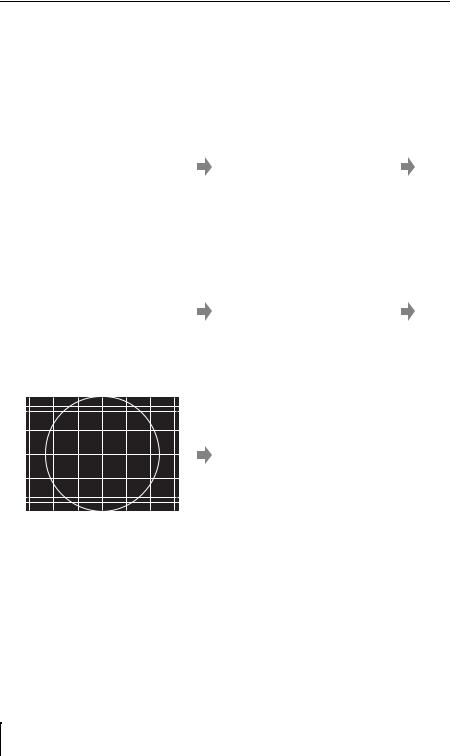
Display the templates and patterns for adjusting an image
Press the PATTERN key of the remote control to display the templates and patterns for adjusting an image on the projected image. There are four templates and one pattern. Every time you press the PATTERN key, the templates/pattern switch. Press the MENU button to return to the previous image.
Template 1 |
|
Template 2 |
|
|
|
|
|
|
Template 3 |
|
Template 4 |
|||||||||||||||||
|
|
|
|
|
|
|
|
|
|
|
|
|
|
|
|
|
|
|
|
|
|
|
|
|
|
|
|
|
|
|
|
|
|
|
|
|
|
|
|
|
|
|
|
|
|
|
|
|
|
|
|
|
|
|
|
|
|
|
|
|
|
|
|
|
|
|
|
|
|
|
|
|
|
|
|
|
|
|
|
|
|
|
|
|
|
|
|
|
|
|
|
|
|
|
|
|
|
|
|
|
|
|
|
|
|
|
|
|
|
|
|
|
|
|
|
|
|
|
|
|
|
|
|
|
|
|
|
|
|
|
|
|
|
|
|
|
|
|
|
|
|
|
|
|
|
|
|
|
|
|
|
|
|
|
|
|
|
|
|
|
|
|
|
|
|
|
|
|
|
|
|
|
|
|
|
|
|
|
|
|
|
|
|
|
|
|
|
|
|
|
|
|
|
|
|
|
|
|
|
|
|
|
|
|
|
|
|
|
|
|
|
|
|
|
|
|
|
|
|
|
|
|
|
|
|
|
|
|
|
|
|
|
|
|
|
|
|
|
|
|
|
|
|
|
|
|
|
|
|
|
|
|
|
|
|
|
|
|
|
|
|
|
|
|
|
|
|
|
|
|
|
|
|
|
|
|
|
|
|
|
|
|
|
|
|
|
|
|
|
|
|
|
|
|
|
|
|
|
|
Pattern for adjusting an image
Returns to the previous image.
12 Projecting an Image
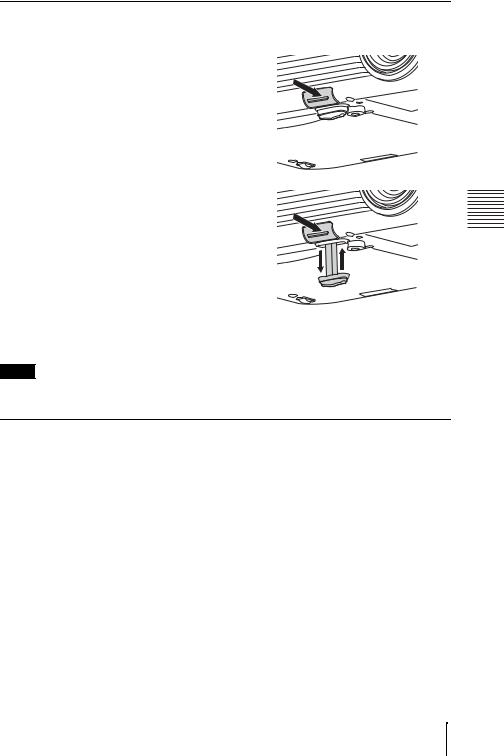
Adjusting with the foot adjust button
You can adjust the position of the projected image by tilting the projector with the foot adjust button.
1Press and hold the foot adjust button, then lift up the front of the projector to
adjust the angle.
2When the desired angle is achieved, release the foot adjust button to lock the position.
Notes
•Be careful not to let the projector down on your fingers.
•Do not push hard on the top of the projector with the front foot (adjustable) extended.
Changing the aspect ratio of the projected image
Press the ASPECT key on the remote commander to change the aspect ratio of the projected image. You can also change the setting in Aspect of the Screen menu (pages 19, 21).
Image an Projecting
Projecting an Image 13
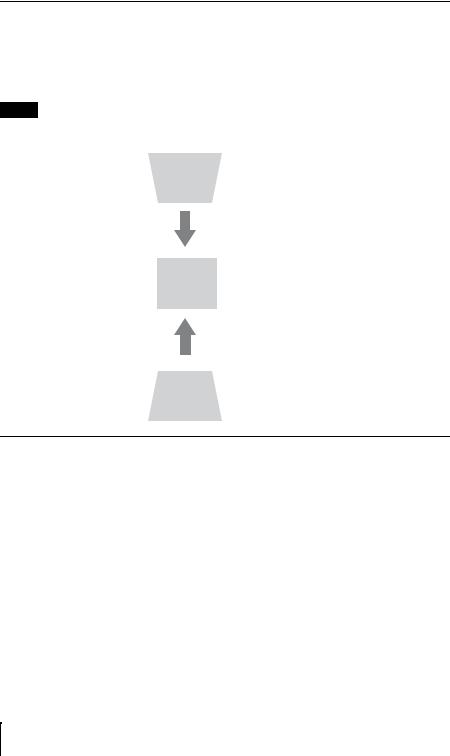
Correcting trapezoidal distortion of the projected image (Keystone feature) *1
Keystone feature may not work automatically*2 when the screen is tilted. In this case, set keystone manually.
1Press the KEYSTONE key on the remote commander or select V Keystone in the Installation menu.
2Use the V/v/B/b the keys to set the value. The higher the value, the narrower the top of the projected image. The lower the value, the narrower the bottom.
Notes
*1: Since the Keystone adjustment is an electronic correction, the image may be deteriorated. *2: VPL-DX270/DX240/DW240 only.
Increase the number towards plus
Increase the number towards minus
Automatically adjusts Phase, Pitch and Shift of projected image while a signal is input from a computer (APA (Auto Pixel Alignment))
Press the APA key on the remote commander. Press again to cancel adjusting during the setting. You can also set APA in the Screen Menu (page 20). If Smart APA in the Function menu is set to “On”, executes APA automatically when a signal is input (page 23).
14 Projecting an Image
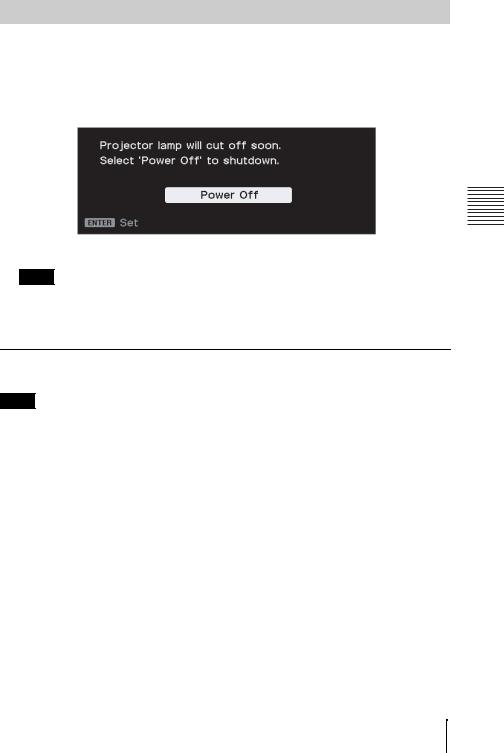
Turning Off the Power
1 Press the ?/1 key on the unit or the remote commander.
The projector starts shutdown and turns off. If you press the ?/1 key within 10 seconds of the message being displayed, shutdown is canceled.
When “Power Supply” is set to “On,” press start to display the message. After about ten seconds, the lamp will turn off, and the unit continues to supply power. Select “Select 'Power Off' to shutdown.” to stop supplying power.
Press the power button while the message is displayed to light the lamp again.
Note
Do not turn off the projector soon after the lamp lights. It may cause a malfunction of the lamp (does not light ,etc.).
2 Unplug the AC power cord from the wall outlet.
Turning off without displaying the confirmation message
Press and hold the ?/1 key on the unit for a few seconds (page 31).
Note
If you turn off the unit soon after the lamp is turned on, the confirmation message will be displayed and may take a longer time for the unit to turn off.
Image an Projecting
Projecting an Image 15

ECO gauge
This gauge indicates the current effectiveness of the projector’s ECO function.
(For details on the ECO function, see “ECO MODE key” (page 6) and “ECO” (page 25).) The leaf icons are displayed when the projector is shut down. The number of displayed icons varies according to how much energy is saved as a result of using the ECO function.
ECO gauge
16 Projecting an Image
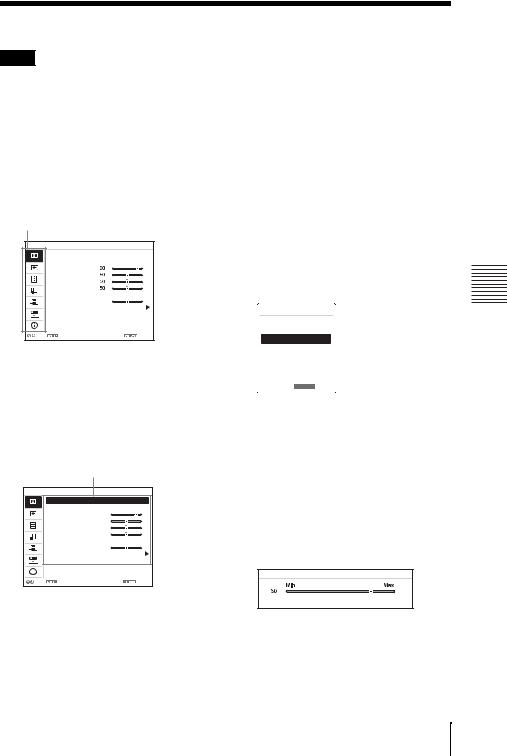
B Adjustments and Settings Using a Menu
Using a MENU
Note
The menu displays used for the explanation below may be different depending on the model you are using.
1 Press the MENU key to display the menu.
2 Select the setting menu.
Use the V/v key to select the setting menu then press the b key or ENTER key.
Setting menu
Picture
|
Picture Mode |
Standard |
|
Reset |
|
|
Contrast |
|
|
Brightness |
|
|
Color |
|
|
Hue |
|
|
Color Temp. |
Low |
|
Sharpness |
30 |
|
Expert Setting |
|
:Sel |
:Set |
:Back |
3 Select the setting item.
Use the V/v key to select the setting menu then press the b key or ENTER key.
To return to the selection screen of the setting menu, press the B or RETURN key.
Setting items
Picture |
|
Picture Mode |
Standard |
Reset |
|
Contrast |
80 |
Brightness |
50 |
Color |
50 |
Hue |
50 |
Color Temp. |
Low |
Sharpness |
30 |
Expert Setting |
|
:Sel |
:Set |
:Back |
4 Make the setting or adjustment for the selected item.
The setting method varies, depending on the setting item.
If the next menu window is displayed, select the item according to the
operations in step 3 and then press the ENTER key to register the setting. To return to the selection screen of the
setting items, press the B or RETURN key. As an aid to setting or adjusting items, you can press the RESET key to return an item to its factory setting.
Using a pop-up menu
Press the V/v/B/b key to select an item. A selected item takes effect immediately, except “Language”, which will take effect after you press the ENTER key.
Picture Mode
Vivid
Dynamic
Standard
Presentation
Blackboard
Whiteboard
Cinema
 :Sel RETURN :Back
:Sel RETURN :Back
Using the setting menu
Press the V/v key to select the item. A selected item takes effect immediately. The previous screen is restored.
Using the adjustment menu
To increase the value, press the V/b key and to decrease the number, press the v/B key. If you press the ENTER key, the selected item takes effect immediately. The previous screen is restored.
Contrast
 Adjust
Adjust  Back
Back
5 Press the MENU key to clear the menu.
The menu disappears automatically if no operation is performed.
Menu a Using Settings and Adjustments
Using a MENU 17
